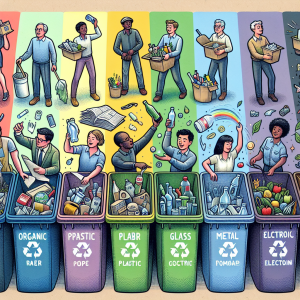Reducing Carbon Footprint: Tips for a Greener Life
Reducing carbon footprint is a crucial step towards a sustainable and environmentally friendly lifestyle. By making conscious choices, individuals can significantly diminish their impact on the planet, contributing to a healthier environment. Carbon footprints are the total greenhouse gas emissions caused by an individual, event, organization, or product, expressed as carbon dioxide equivalent. Here are practical steps to help you reduce your carbon footprint and lead a greener life.
Energy Efficiency at Home:
Improving energy efficiency is a straightforward approach to minimizing carbon emissions. Begin by conducting an energy audit to assess your home’s current energy usage. Simple measures such as switching to LED bulbs, which consume up to 80% less energy, can make a substantial difference. Installing programmable thermostats aids in reducing unnecessary heating and cooling, automatically adjusting the temperature when you’re not at home. Weatherproofing your home by sealing windows and doors prevents heat loss, which in turn reduces energy consumption. Additionally, consider using energy-efficient appliances which have the Energy Star label for guaranteed efficiency.
Sustainable Transportation Choices:
Transportation is a significant contributor to carbon emissions. Opt for public transportation, biking, or walking whenever possible. If driving is necessary, carpooling with coworkers or friends effectively reduces the number of vehicles on the road, minimizing emissions. Consider transitioning to a hybrid or electric vehicle, which produces fewer greenhouse gases compared to traditional gasoline-powered cars. Moreover, regular vehicle maintenance, including keeping your tires properly inflated, ensures your car runs efficiently and uses less fuel.
Mindful Consumption and Waste Reduction:
Adopting a minimalist lifestyle can vastly reduce your carbon footprint. Practice mindful consumption by purchasing only what you need and opting for second-hand products instead of new ones. Reducing waste also involves meticulous recycling and composting. Recycling reduces the demand for raw materials, thus cutting down on energy expenditure and emissions involved in production. Composting organic waste returns nutrients to the soil and reduces the amount of waste sent to landfills, where it would decompose and produce methane, a potent greenhouse gas.
Dietary Changes for Sustainability:
The food choices you make have a significant impact on your carbon footprint. Consider transitioning to a plant-based diet, which is lower in carbon emissions compared to diets high in meat and dairy. The production process of animal products requires a higher energy, land, and water footprint. Incorporate more local and seasonal produce into your meals, as this reduces the carbon emissions associated with transporting food over long distances. Engage in mindful meal planning to reduce food waste, and where possible, grow your own fruits and vegetables to ensure fresh and sustainable produce.
Water Conservation Efforts:
Water conservation is an often-overlooked aspect of reducing one’s carbon footprint. Simple practices such as fixing leaks promptly, taking shorter showers, and using water-efficient fixtures can lead to significant savings in water and energy usage. Limit lawn watering and consider xeriscaping, a landscaping method that utilizes drought-resistant plants, which require less water. Additionally, harvesting rainwater through collection systems can supplement water needs for outdoor use.
Smart Use of Technology:
Technology, when used judiciously, can be a powerful ally in reducing carbon emissions. Embrace smart technology that monitors energy usage and adjusts accordingly, such as smart meters, which provide real-time insights into home energy use. Telecommuting tools and virtual meeting platforms can reduce the carbon footprint associated with commuting and business travel. When purchasing gadgets, opt for those with high energy efficiency ratings, and always unplug devices not in use, as even in standby mode, they consume power.
Greening Workplaces:
The workplace is another arena where individuals can push for better practices. Advocate for green office initiatives such as reducing paper use and implementing recycling programs. Encourage your company to source renewable energy and promote remote working policies to lessen the environmental impact associated with commuting. Designing a green office environment by utilizing natural light and incorporating plants can also improve air quality and enhance employee well-being.
Community Involvement and Advocacy:
Encouraging community action towards sustainability can create a ripple effect. Participate in local clean-up drives or tree planting activities to foster a greener environment. Join environmental advocacy groups focused on promoting policy changes at various governmental levels. Engage in conversations that raise awareness of the importance of reducing carbon footprints within your community. By sharing knowledge and resources, communities can work collectively towards a more sustainable future.
Invest in Renewable Energy:
Investing in renewable energy sources is a significant step toward reducing carbon emissions. If possible, install solar panels to harness clean energy, reducing reliance on fossil fuels. For those unable to install solar panels, choose a green energy provider that sources power from renewable energies. Additionally, consider investing in community solar programs that allow you to buy into larger solar projects, contributing to broader clean energy adoption.
Conscious Lifestyle and Habits:
Embrace a lifestyle that prioritizes environmental sustainability. Reduce consumption by rethinking your buying habits, choosing quality over quantity, and supporting companies with sustainable practices. Practice conscious travel by selecting eco-friendly accommodations and destinations actively working towards sustainability. Personal carbon footprint can be further reduced by offsetting emissions through certified carbon offset programs that support projects aimed at reducing or removing carbon from the atmosphere.
Education and Awareness:
Continuously educating yourself and others about environmental issues and sustainable practices is fundamental. Stay informed about new technologies and strategies to lower carbon emissions and share this knowledge with those around you. Encourage environmental education in schools and local communities to foster a generation that values sustainability. By raising awareness, more individuals can grasp the importance of reducing their carbon footprint, prompting wider societal change.
By integrating these practices into daily routines, individuals can significantly impact the environment, leading to a sustainable and healthier planet. Each small action contributes to larger global efforts, ensuring the preservation and protection of natural resources for future generations. Prioritizing sustainability in personal choices not only aids the environment but also promotes personal well-being and a sense of collective responsibility towards planetary health.



